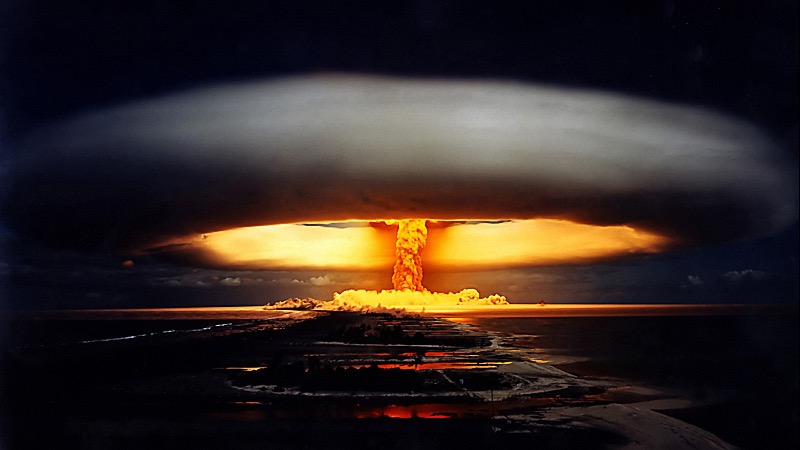 Image Credit: Galerie Bilderwelt / Contributor / Getty
Image Credit: Galerie Bilderwelt / Contributor / Getty On Sunday Russian President Vladimir Putin announced that Moscow again tested its nuclear-powered Burevestnik missile, often referred to as a “doomsday” weapon since it would be used to finish off an enemy following a nuclear exchange. The Burevestnik has been in development since 2011 and has been tested numerous times since 2016, often leaving behind radioactive waste and even dead Russian nuclear specialists. Moscow was not the first to develop an “armageddon cruise missile from hell” however, nearly 70-years ago the United States developed its own atomic-powered missile intended to leave no survivors after a nuclear conflict.
In 1957 the United States government launched Project Pluto – a nuclear-powered cruise missile referred to as the Supersonic Low Altitude Missile or SLAM, which used a ramjet engine powered by a small nuclear reactor.

Ramjets use the high-speed airflow going into the engine’s inlet to compress the air before a fuel source heats and expands the air so as to create thrust. Ramjets are often launched by conventional chemical rockets to bring them up to speed. Once up to speed, SLAM (and Burevestnik) would superheat the incoming air via its nuclear reactor instead of with a traditional chemical fuel.
During development, the American engineers found that, if deployed, the design would emit radioactive exhaust particles as it flew just above the treetops at very low altitudes, dropping multiple atomic or perhaps hydrogen bombs before creating its own radiological crash site – its only method of coming back to earth – making actual in-air testing problematic.
Referred to as an “armageddon” or “doomsday” weapon, SLAM’s purpose would be to inflict the maximum amount of damage to an enemy following the initiation of a nuclear conflict. Notably, SLAM would not be a first-use weapon, as its long flight times would only serve illicit a retaliatory response.
Project Pluto continued into the mid-1960s, with a successful 5-minute ground test of the nuclear ramjet engine in 1964 at Jackass Flats in the Nevada Test Site before being canceled later that year. There were plans to flight test SLAM in the Pacific, crashing it into one of the U.S.’s nuclear test site islands, but that never materialized.

The idea of a nuclear-powered ramjet carried on into the 1970s under the NERVA/Rover program, using hydrogen in space rather than atmospheric oxygen on earth. The think tank BASIC detailed these U.S. programs – note they state the year Project Pluto began as 1956:
The idea of a nuclear-powered cruise missile is not new. The United States ran two open-loop propulsion reactor projects from 1956-1973: Project Pluto, which consisted of two reactors – Tory-IIA and Tory-IIC – for a supersonic nuclear ramjet; and Project Rover, which later became the NERVA program for propulsion in space, using hydrogen as the working fluid rather than atmospheric air. Tory was tested twice in the early 1960s, proving itself as a concept, and twenty reactors were built and tested for the NERVA/Rover program between 1959 and 1972. In both programs, the reactors were shown to degrade during use and produce radioactive particulate matter in the exhaust. Cheryl Rofer provides an excellent breakdown of those projects and their relation to Burevestnik here, and reading these is highly recommended for those that want to dig a little deeper into this issue.
Russia’s version, Burevestnik (called Skyfall by NATO), has been in development since 2011, beginning before the 2014 coup in Ukraine, yet after the 2008 Western-backed attack on Russia out of Georgia.
“Russia’s development of the Burevestnik began in 2011 in connection with the U.S.’s withdrawal from the Anti-Ballistic Missile Treaty of 1972. In the spring of 2018, Russian President Vladimir Putin said in his annual address to the Federal Assembly that the planned nuclear power engine for the Burevestnik would give it a virtually unlimited flight range, and that it can also fly at a low altitude due to its landscape tracking system,” UAwire said.
Similar to Project Pluto, Burevestnik would be used following a nuclear exchange. Conversely, Burevestnik would fly at subsonic speeds rather than the 1950’s American missile’s supersonic speeds. As a weapon for ending civilization however, this slower speed is likely not an issue.
“Some Western experts say the Burevestnik’s subsonic speed would make it detectable, and it would become more vulnerable the longer it stayed in flight,” Reuters said Sunday. “Responding to this, Russian military expert Alexei Leonkov wrote in 2019 that the role of Burevestniks would be to eliminate the ‘remnants’ of the enemy’s command posts, military bases, factories and power plants after Russia had already fired intercontinental ballistic missiles, by which point the opponent’s air-defence systems would be incapable of stopping them. He said Burevestniks would ‘trample the aggressor countries into the Stone Age’, completing the destruction of their military and civilian infrastructure.”
While SLAM had an open-loop nuclear ramjet system (the actual air entering and exiting the engine directly contacted the nuclear reactor and thus became highly radioactive), Moscow has to this day remained hushed as to if their Burevestnik’s reactor uses an open-loop or a safer closed-loop design which employs a heat exchanger so as to not emit radioactive exhaust gasses.
The think tank BASIC detailed the two possible propulsion system designs:
The reactor that heats the air in the ramjet is a black box as far as open source material is concerned; there are no known design parameters. But to function as an engine, one can assume its primary function is to heat incoming air. Broadly speaking, there are two reactor configurations that could reasonably be considered here: ‘open-loop’, where the incoming air flows straight through the reactor to extract the heat and propel the missile, or ‘closed-loop’, where the reactor is isolated from the airflow by a heat exchanger that transfers the reactor’s heat to the air.
Both configurations bring their own challenges. Open-loop systems would have radioactive particulate matter in the exhaust and need to be large. The geometry of the reactor is extremely important, and ducts for airflow would increase the amount of fuel needed for critical mass to be achieved, thereby increasing system weight. Closed-loop systems would have less mass in the reactor, but this might be offset by the mass, volume and packaging issues of the heat exchangers, which would likely use liquid metal coolants like sodium and potassium.
Some sources imply that Burevestnik could use a closed-loop 1-20 MW microreactor, but the reference for this claim is a US Department of Energy (DoE) microreactor explainer video and factsheet showing a concept reactor fitting on the back of a semi-trailer truck. Miniaturising a reactor from shipping container-sized to cruise missile-sized is no mean feat, especially a high temperature reactor such as the type needed for a nuclear ramjet.
The added complexity of introducing a heat exchanger into the design would make an open-loop concept more attractive to the engineers within the context of rapid testing and deployment, as well as the political pressure of Putin’s political unveiling of the weapon in 2018. Therefore, if it is an open-loop system, then the question becomes: what happens to the radioactive exhaust?
In an open-loop system, the air will flow through the reactor core before being ejected as exhaust, but the air itself won’t be made radioactive. The primary radiological concern is from degradation of reactor materials as a function of the heat, pressure, and intense radiation of operation. As these materials degrade, they may chip off and exit through the exhaust. These particles will be radioactive, but the amounts released depend on technical details that are not in the open source.
It seems reasonable to assume that even under optimum performance, some radioactive material will be released.
In a publication from the think tank Nuclear Threat Initiative (NTI) published in 2019 titled “Russia’s New Nuclear Weapon Delivery Systems – An Open-Source Technical Review,” Burevestnik’s technical details were theorized on and the missile’s checkered history, complete with accidents and radioactive releases, were detailed beginning on page 33. NTI also said in their 2019 report that the Russian’s expected 2025 deployment date for Burevestnik is highly unlikely, although Sunday’s test may prove that prediction wrong.
On page 34 NTI theorized that Moscow is likely using a closed-loop system on their Burevestnik, but then on page 35 chronicled testing of the missile conducted from 2016 to 2019 and its associated radiological releases:
Despite the potential dangers, the development of the Burevestnik is reported to have begun in 2011, with tests beginning by June 2016. There is a consensus in the press, with purported agreement from U.S. intelligence services, that the Burevestnik has been tested 13 times, with two partial successes. It is believed that a test in September 2017 resulted in a cloud of Ru-106 radioactivity with a source between the Urals and the Volga River. The partially successful test conducted in November 2017, and referred to by Putin in his 2018 address, consisted of a launch from a mobile platform in Novaya Zemlya followed by about two minutes of flight and then a descent into the Barents Sea.
Reuters discussed how “Superheated and possibly radioactive air would be blasted out, providing forward thrust,” while also chronicling Burevestnik’s characteristic of leaving behind radioactive pollution:
The Burevestnik has a poor test record with numerous past failures, according to Western experts. In 2019 at least five Russian nuclear specialists were killed in an explosion and release of radiation during an experiment in the White Sea, and U.S. intelligence sources said they suspected it was part of a test of the Burevestnik. Putin presented their widows with top state awards, saying the weapon they were developing was without equal in the world, although he did not name it. Putin announced a successful test of the missile in October 2023.
Regardless of design or even development risks, both the older American and newer Russian nuclear-powered missiles are “doomsday” or “armageddon” weapons – intended to ensure that a nuclear war is not survivable. Their development is likely geopolitical in nature, serving as a nuclear checkmate, ensuring that the notion of a “survivable” nuclear exchange remains out of the military discourse.
The Burevestnik is “unstoppable” because it is to be used after a nuclear conflict to kill off the survivors when no air defenses remain. Russia’s non-nuclear Oreshnik missiles are “unstoppable” because of their high rate of speed. The Oreshnik is designed for first strike capability and has already been used in battle, the Burevestnik is designed for last strike destruction.


